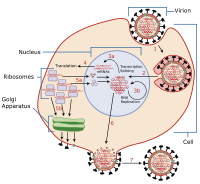
Photo from wikipedia
Viruses and other genetic parasites are present in virtually all forms of life. This chronic condition has led to diverse host cell adaptations such as CRISPR and RNAi, whose functions… Click to show full abstract
Viruses and other genetic parasites are present in virtually all forms of life. This chronic condition has led to diverse host cell adaptations such as CRISPR and RNAi, whose functions attenuate these parasites. It is hypothesized that programmed cell death (PCD) is an additional adaptation whose origins reside in viral defense. A core event of apoptotic PCD is the regulated release of mitochondrial inter-membrane space proteins into the cytosol, following which these apoptogenic proteins bring about the demise of the cell. The most well studied example of this is found in animals, where the release of mitochondrial cytochrome C nucleates the formation of the apoptosome, which then activates caspase mediated cell death. The release of mitochondrial proteins contributes to PCD in diverse organisms lacking the apoptosome, indicating that regulated mitochondrial release predates the evolution of canonical apoptosis. Using the budding yeast Saccharomyces cerevisiae, we recently confirmed an early study showing that Nuc1, a homolog of the mitochondrial apoptotic driver protein Endonuclease G, attenuates cytosolic double stranded RNA (dsRNA) viruses, which are endemic to yeast and many other organisms. Viral attenuation by Nuc1 occurs most prominently during meiosis and in association with its developmentally programmed relocation from the mitochondria to the cytosol. Intriguingly, meiotic viral attenuation by Nuc1 occurs within the context of meiotic PCD of the superfluous mother cell that we have also discovered. These findings are discussed here.
Journal Title: Microbial Cell
Year Published: 2019
Link to full text (if available)
Share on Social Media: Sign Up to like & get
recommendations!